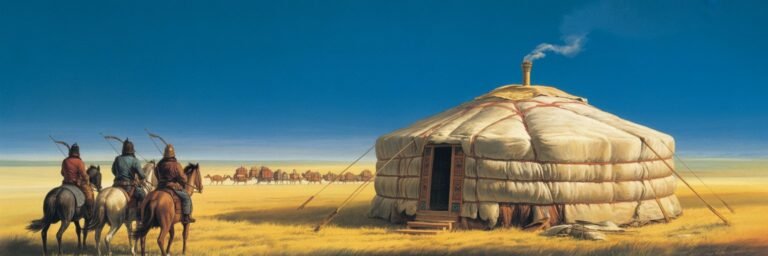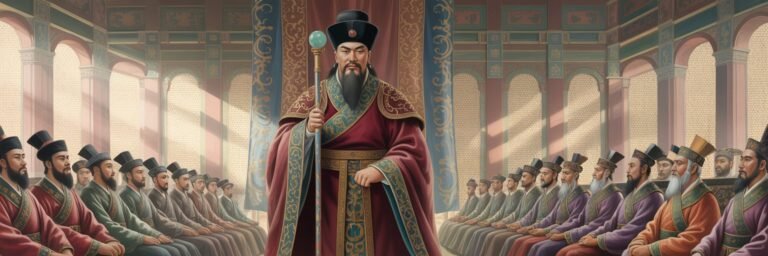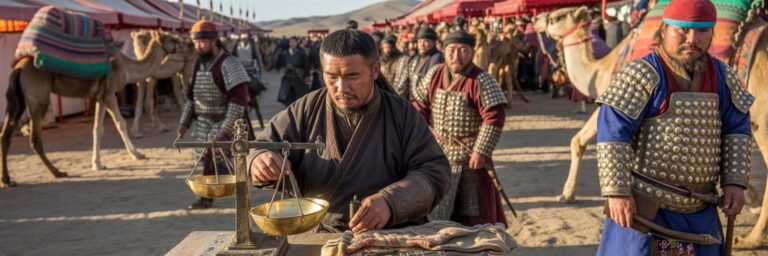INTRODUCTION
The following discourse delves into a noteworthy aspect of human history, the Mongol Empire, and more specifically, its legacy of war. When one mentions this particular historic dominion, it elicits images of marauding horsemen, sweeping conquests, Genghis Khan galloping over the steppe with his golden horde, and cities reduced to rubble in their wake. Yet, their impact extends far beyond mere military conquest. The Mongols forged an empire that connected and reshaped the world, leaving a legacy of war that continues to echo, often in unexpected ways, through the corridors of history until today.
HISTORICAL BACKGROUND
From its birth under the auspices of the brilliant and ruthless Genghis Khan around 1206, the Mongol Empire grew to be the largest contiguous land empire in history. From the eastern shores of modern-day Korea to the vast plains of Hungary, it imposed its militaristic ethos, administrative efficiency, and perhaps surprisingly tolerant diplomatic attitudes upon a sizable fraction of the then-known world.
The Mongol military was the cornerstone of their power, masterfully blending steppe traditions like superior horsemanship with the best practices adopted from conquered cultures, including refined strategies and cutting-edge siege warfare technology. This enabled rapid expansion and Shah Ala ad-Din Mohammed, among many; fell before this relentless march.
THEORIES AND INTERPRETATIONS
Academic interpretation of the Mongol Empire’s legacy of war is unsurprisingly multifaceted and contentious. Prevailing mainstream views, spearheaded by scholars such as George Vernadsky, foster the image of the Mongols as mere agents of destruction, who razed regions to the ground with scant regard for human life or culture.
Conversely, less conventional theories posit that their conquests, despite their brutality, catalyzed dialogue and fusion among different civilizations. Historian Jack Weatherford advocates this view, asserting that the Mongols stimulated diverse exchanges – cultural, intellectual, and technological – between the East and West.
MYSTERIES AND CONTROVERSIES
The Mongol Empire is rich with mysteries that trigger debates among historians. The death of Genghis Khan, for instance, continues to be shrouded in mystery, with accounts ranging from injuries sustained in battle to a fall from his horse.
A longstanding controversy involves the enormous death toll attributed to the Mongol invasions. While it’s impossible to validate the 40 million deaths often claimed, historians such as Stephen Morillo argue that the ecological impact of the Mongol conquests, which led to depopulation and reforestation, had a carbon-cooling effect—a starkly different perspective to the ravaging hordes narrative.
SYMBOLISM AND CULTURAL SIGNIFICANCE
The Mongol Empire, through its legacy of war, holds profound cultural and symbolic significance. The unparalleled horsemanship, battle acumen, and indomitable spirit of the Mongols inspired awe, fear, and respect, elements that have permeated into historical narratives, literature, films, and even national ethos.
In the West, the Mongols, perhaps unfairly, symbolize unbridled aggression and conquest. Meanwhile, in Mongolia itself, Genghis Khan is viewed as a national hero, an embodiment of Mongolian cultural pride and identity.
MODERN INVESTIGATIONS
Modern investigations into the Mongol Empire’s legacy of war have been facilitated by an array of academic disciplines such as genetics, archaeology, and climatology.
For instance, genetic studies have shown a significant presence of Genghis Khan’s lineage in the modern world, underscoring the demographic impact of the Mongol conquests. Similarly, archaeological findings continue to unearth insights into Mongol warfare and societal structures, with excavations in Mongolia and beyond revealing vast burial sites and lost cities.
LEGACY AND CONCLUSION
On balance, the Mongol Empire’s legacy of war, while marked by destruction and bloodshed, also catalyzed change and innovation. The Mongols were the synthesizers of their age, borrowing and amplifying the successful practices of those they conquered, thus facilitating a vibrant exchange of ideas and technologies.
The legacy continues in our universities, hospitals, paper money, diplomatic immunity and, more controversially, in the genetic imprints left by the Mongols. Thus, their militaristic ethos and sweeping conquests brought a violent edge to the process of globalization, preceding the modern age by several centuries.
In conclusion, the Mongol Empire’s legacy of war serves as a potent reminder of the force of human will, the fluidity of cultural exchange, and the paradoxical ability of conflict to forge connections—triggering an enduring dialogue between the past and the present, stretching across continents, cultures, and generations.






